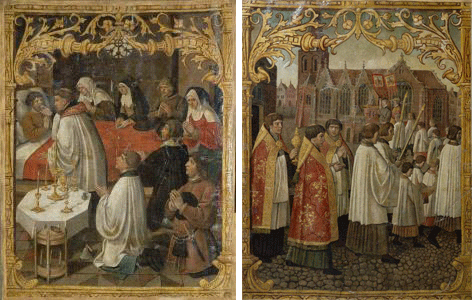It is a cold wintery night, the night of 15 to 16 March. In a house on Die Lane – modern Kalverstraat – a man is lying in bed, at death’s door. Fearing the worst, he calls for a priest. The priest from St Nicolas’s church - today’s Oude Kerk - arrives with a consecrated wafer and the paraphernalia to send the man in his final journey. Later that night, the man vomits and spews up the wafer. His nurse throws the vomit in the fire, stirring the peat to keep the flames burning through the night. When she returns the next morning and begins to tend the fire she is astonished to find the wafer, pristine and unscathed by the flames. Bravely she reaches into the fire to retrieve the consecrated body of Christ, without burning herself at all. She places the sacramental wafer on a cushion in the linen cupboard. The priest is called and he comes immediately to investigate. He puts the wafer in a pyx and secretly takes the sacred object across town to Oude Kerk. The next morning, the wafer is found once more at Kalverstraat: it has miraculously returned. The amazed priest takes the wafer a second time. To no avail. Again the wafer is found in the cupboard the next day. On the third day, the divine message is clear: obviously it is divinely ordained that the miracle be made public. The wafer is brought with due pomp and ceremony in a procession of all of Amsterdam’s clergy to Oude Kerk where it finally finds peace.
On the site of the actual miracle a chapel is built - the Heilige Stede- which opens in 1347 and where the miraculous wafer is venerated. Pilgrims start coming to Amsterdam and the city grows. And what became of the sick man? History leaves that to our imagination.

